The Samsung Galaxy S7 & S7 Edge Review, Part 1
by Joshua Ho on March 8, 2016 9:00 AM ESTSoC Performance
While we’re ready to move on to newer benchmarks for 2016, our system performance benchmarks from 2015 are still going to provide a pretty good idea for what to expect from the Galaxy S7 and Snapdragon 820 by extension. For those that are unfamiliar with what the Snapdragon 820 is, I’d reference our previous articles on the Snapdragon 820.
In essence, we’re looking at a 2x2 CPU configuration with 2.15 GHz Kryo cores for the performance cluster, and 1.6 GHz Kryo cores for the efficiency cluster. Binding the two clusters together are some power aware scheduling at the kernel level and a custom interconnect to handle coherency between the two clusters. Memory is also improved relative to the Snapdragon 810, with a bump to LPDDR4-1866 over the former's LPDDR4-1600. Of course, there's a lot more to talk about here, but for now we can simply look at how the Snapdragon 820 compares in our benchmarks.
Update: As we've had a few questions on the subject, I just want to clarify browser testing. Samsung's stock browser was not included with our Verizon-branded sample phone, nor is it possible to install it at this time. As a result we are unable to test the performance of Samsung's browser. The Verge reports that this is a Verizon decision and that all Verizon phones will be shipping like this; so for these phones Chrome is the de-facto stock browser.
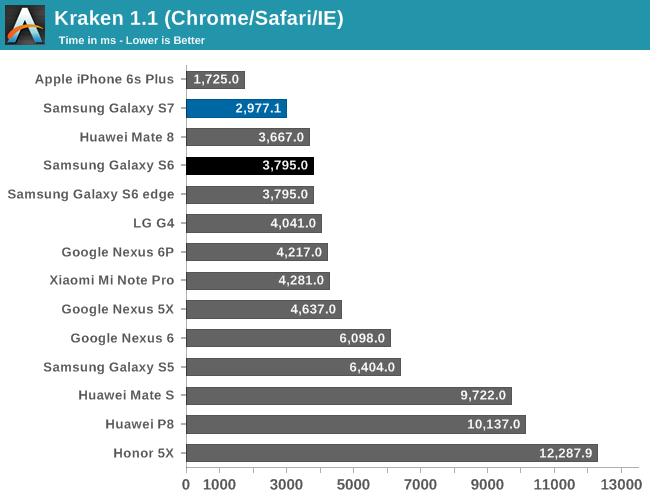

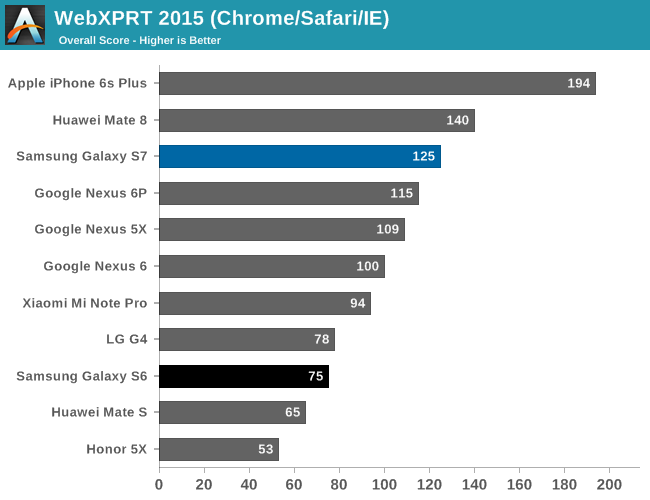
Starting off with our web benchmarks, we can see that in the time since our initial testing of the Snapdragon 820 MDP there have been some major improvements to how well Chrome is optimized for Kryo. As a result we're seeing results that are almost comparable to Snapdragon Browser in Chrome.
Overall then the Galaxy S7 and its Snapdragon 820 SoC won't top the charts on web benchmarks - Apple still holds an edge here - however the Galaxy S7 puts up a solid fight. The one drawback here is that the Mate 8 and its Cortex A72 CPU seems to have the edge over the Galaxy S7.
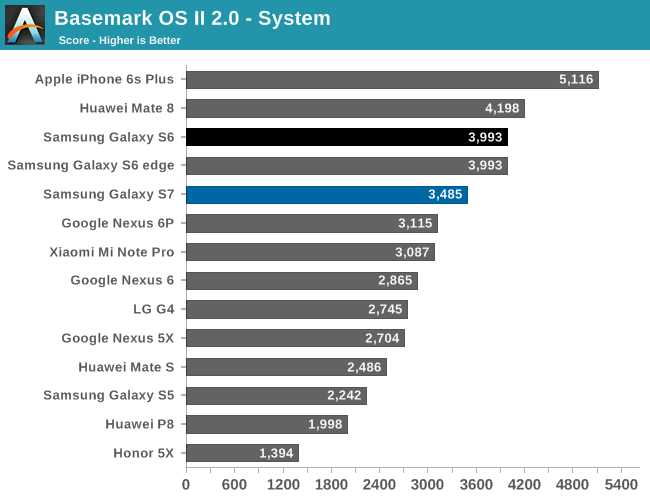
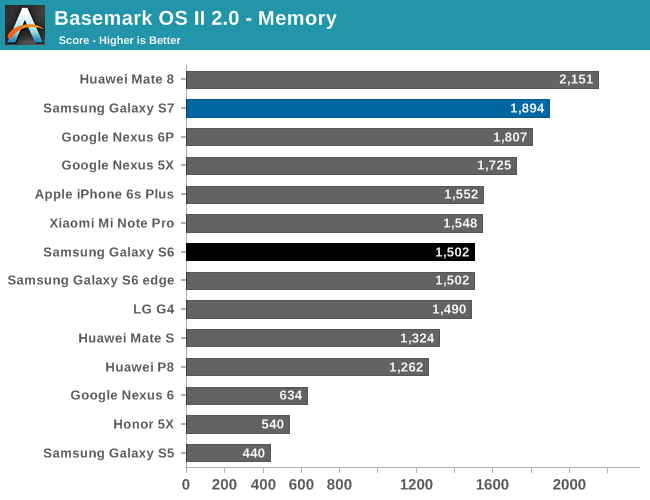
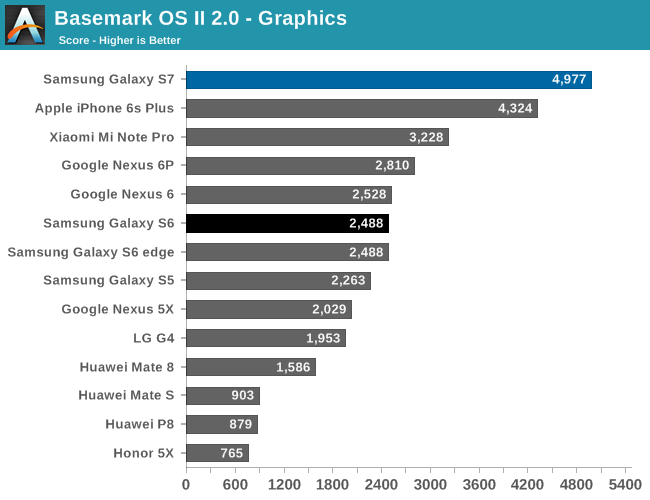
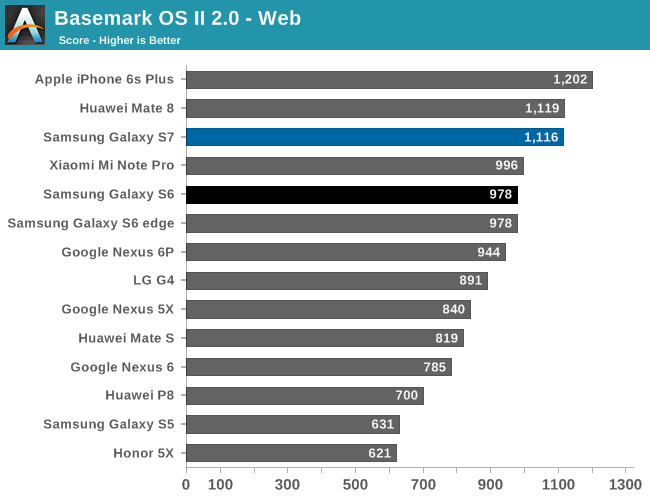
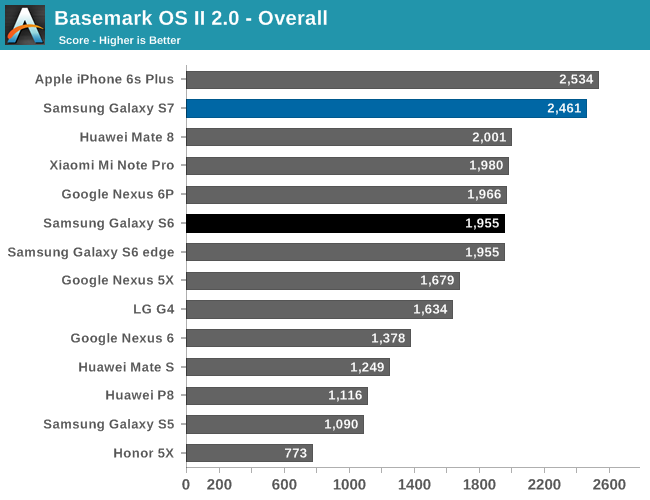
In Basemark OS II the combination of a better GPU, better NAND, and better single thread CPU performance seems to be enough for the Galaxy S7 to approach the iPhone 6s Plus in overall performance. While the system benchmark shows that Kryo isn't quite going toe to toe with Twister, the Adreno 530 helps to narrow the gap in the graphics test.
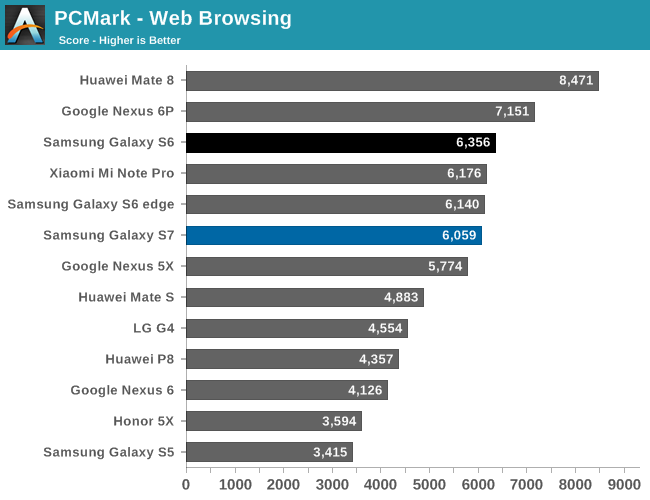
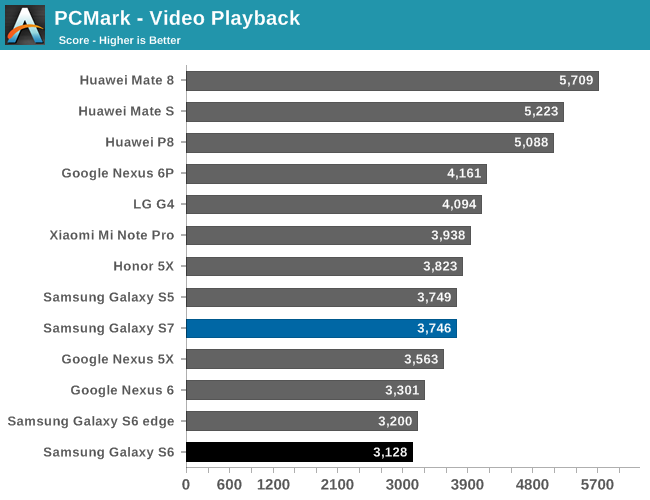


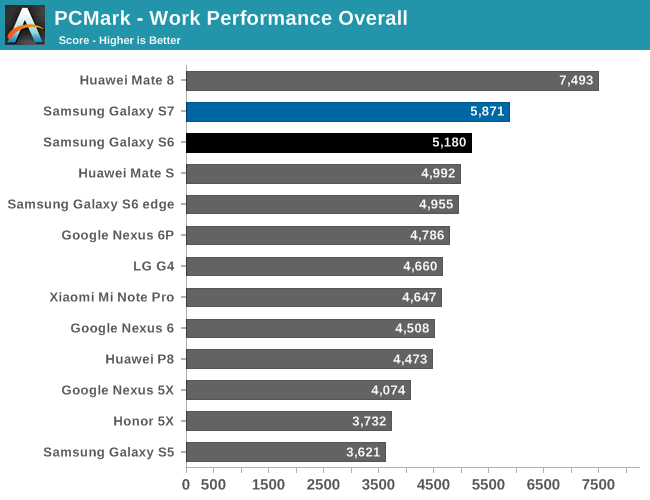
In PCMark, we can see that the Galaxy S7 is mostly comparable to the Galaxy S6. However major improvements in areas like GPU performance help to give it an overall advantage relative to the Galaxy S6 in the photo editing test. Given that this is basically a test of API-level performance, it's likely that Samsung's frameworks and governor settings lead to mostly similar performance in these tests.
Overall, the Snapdragon 820 appears to provide a pretty healthy bump in performance over almost every SoC seen in 2015, although it's hard to declare a clear winner when comparing it to Apple's A9 or Huawei's Kirin 950. If you glanced at the battery life graphs and the performance graphs above it's pretty obvious that Qualcomm has made some enormous strides here. While not quite going from zero to hero, Qualcomm has come close, and that definitely deserves some credit.
NAND Performance
If you think about the memory hierarchy, while RAM and cache are important, at the end of the day the most important aspect is the base storage. Even if you have infinite RAM and cache, if your storage is sufficiently slow the user experience is going to be painful for at least the first time you have to load something.
In order to test this, we use our standard test of AndroBench with 4 KB and 256 KB reads and writes for random and sequential tests. I went ahead and did some digging around to figure out exactly what it is we’re testing in the Galaxy S7, and it turns out that while the Galaxy S7 storage solution is similar to what’s in the Galaxy S6 and S6 edge, it isn’t quite the same. The Galaxy S7 UFS storage identifies itself as the KLUBG4G1CE-B0B1, which looks to be in the same family and appears to have been released at pretty much the same time as the Galaxy S6 storage solution, but the model number isn’t quite the same.
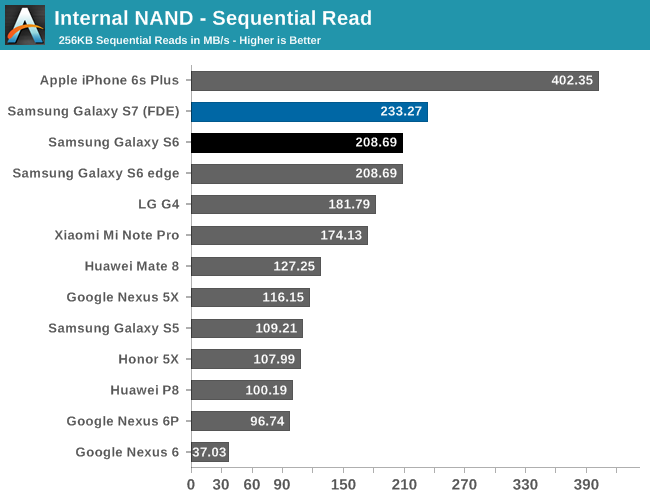
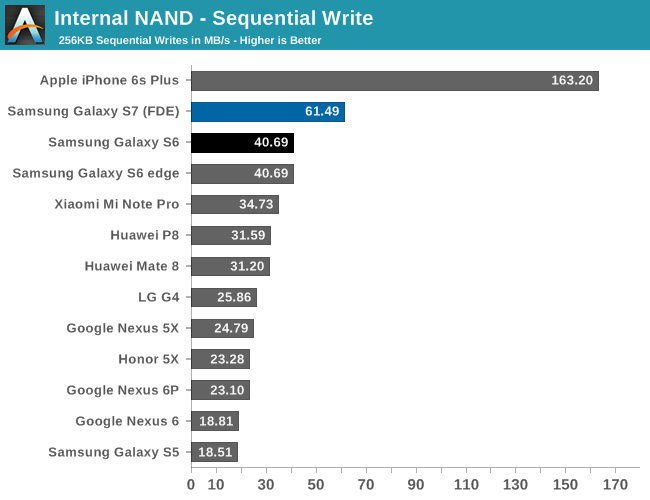
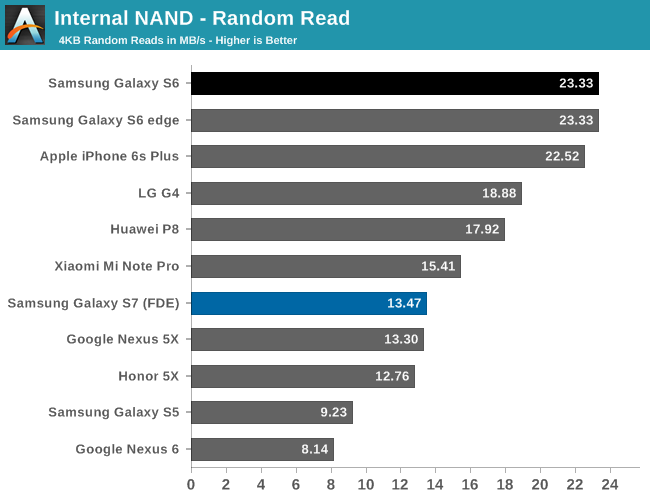
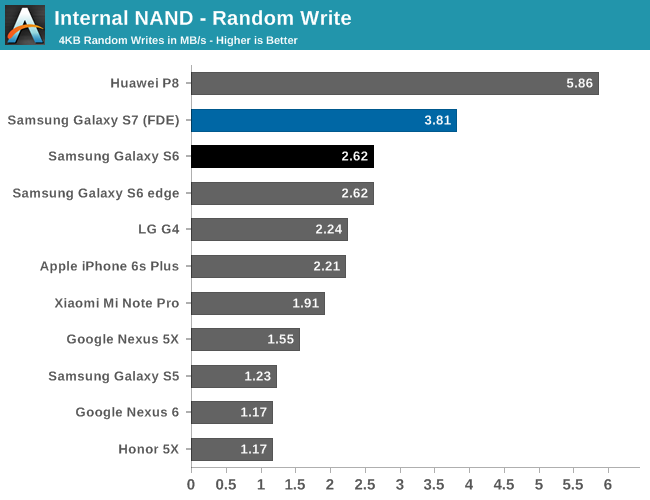
Looking at the performance results, we can also see that the Galaxy S7 is pretty similar to the Galaxy S6 in storage performance at a high level. Interestingly enough despite using full disk encryption on the Galaxy S7, we don’t really see a noticeable degradation in performance relative to the Galaxy S6 which is good to see considering the number of Android devices that do have noticeable performance effects when enabling FDE.










202 Comments
View All Comments
fanofanand - Tuesday, March 8, 2016 - link
I have to agree with this assessment, I won't buy another phone without an IR blaster. I have 3 kids, and the remotes are ALWAYS missing.iheresss - Tuesday, March 8, 2016 - link
There is no such thing as 'shot noise'. Every digital noise is just lack of light to hit sensor. By having larger pixel size means larger area for light to hit photo sensor hence reduce the 'sensor noise'.ah06 - Tuesday, March 8, 2016 - link
But unless the total size of the sensor is increased, isn't increasing the pixel size making only a minor difference?A 1/2.5" sensor is only going to collect X amount of light whether it collects it over 16 million 1.1 um pixels or 12 million 1.4 um pixels.
The only (very slight) gain over the higher pixel count is the loss at pixel boundaries due to pixel pitch.
Am I wrong?
frostyfiredude - Tuesday, March 8, 2016 - link
Because the sensing area is larger per pixel, the number of photons incident in each pixel will increase with it. Those incident photons are what give the picture data. So weird quantum effects that somewhat simulate adding or removing photons have less significance when there are more photons to begin with.More specifically at 1.1um vs 1.4um, 1.1um being quite comparable to the wavelength of visible light is causing some extra anomalous effects too.
ah06 - Wednesday, March 9, 2016 - link
Yea I knew 1.1 um was the bare minimum due to quantam effects. But say going from 1.4 um to 2.0 um, would that make much of a difference?After all the total amount of light collected by the sensor would be roughly same right?
A flower can be composed of 10 million pixels of size X or 5 million pixels of size 2X, the total area of the flow will still have collected the same light?
Where am I going wrong with this :P?
arayoflight - Tuesday, March 8, 2016 - link
Actually no. The sensor on s7 is a 4:3 1/2.5" sensor while the one in s6 us a 16:9 1/2.6" one.What it means is that it collects about 21.49% more licht than the one on s6.
ah06 - Wednesday, March 9, 2016 - link
You're right about the aspect ratio difference, hope more reviewers cover that there is no "Real" loss of resolution .However, does increasing pixel size really affect total light collected by sensor?
jospoortvliet - Friday, March 11, 2016 - link
I don't think it does, but it decreases noise caused by chance: with smaller pixels you have noise in low light situations in part simply due to the chance of one pixel catching randomly a bit more licht fotons than correctly represented the scene, and another less. With bigger pixels you smooth that out a bit and thus less random noise. It is only ONE source of noise, but it helps.Just imagine you take a pic of the same scene with two sensors, one so small it catches 5 photons average per pixel cell, the other one is twice as big and catches, on average, 10. A random one photon difference in a given pixel cell gives 20% brighter or darker pixels on the small, 5 photon-catching sensor and only 10% on the bigger one.
Again, it is only one source of random noise, but a pretty fundamental one you can hardly calculate your way out off.
adamto - Tuesday, March 8, 2016 - link
@Joshua Ho. Do you mind if I ask favor? Does S7 support AC tethering? Do you now any other Android phone with AC tethering? I am not talking about connecting S7 phone to a 5Ghz wifi such as home internet. These days most phone can connect to 5GHz wifi anyway. What I am asking is. If S7 itself can become a 5Ghz WiFi hotspot. This is can be very useful feature for me for transferring files between connected device to S7 tethering. I appreciate if you share with us a screenshot of network connection speed at PC to the S7 tethering at second part of review. Thanks!nerd1 - Tuesday, March 8, 2016 - link
Web browsing bench using chrome AGAIN????? How many times have anandtech been criticized for this?